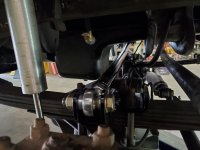At the time, Ford didn't design their Super Duty front suspensions with a bunch of wheel travel or "flex". They also used a shorter track bar with rubber bushings at both ends, but in general, a track bar on a leaf spring suspension is overkill and at worse, can result in bind. I've seen a few track bar mounts on leaf sprung trucks end up ripping themselves off the frame on trucks that also had lots of suspension travel. OTOH, if that truck isn't off roaded much, if at all, then the track bar will likely stay put.
The reason that track bars don't normally come with leaf sprung trucks is; First, leaf springs have enough lateral stability, to track straight and true without one. Exceptions to tracking true are when the spring bushings wear out or they are lifted with parts that give up some of that stability, for example, longer shackles that deflect or leverage their rubber bushings during suspension flex.
Second, when the suspension is flexed, the track bar swings in an arc, pivoting from the frame mounted bushing or joint. However, with leaf springs, the axle can't swing in that same arc. For it to do so requires that the leaf springs must allow for the axle to move side to side which they can't do. Or the spring bushings have to give, or the track bar has to bend, or the mount has to bend.
Going back to the Super Duty example, the track bars they used had rubber bushings at both ends which deflected enough to relieve the bind and the suspension itself was limited to about 3-4 inches of wheel travel.
Ed



